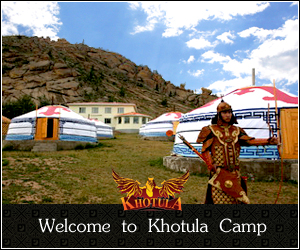Remains of Cities and Ruins in Khentii Aimag
 I. Setsenkhan’s Palace Museum
I. Setsenkhan’s Palace Museum
A base of the khan’s palace in Setsenkhan aimag, Khalkh, was first built in 1691 and there are wall fence around the palace and red, white and brown bulwarks inside the palace. There were temples where khan’s idols were worshipped for many years in the red bulwark, temples where khan’s treasure was kept in the white bulwark and khan’s office in the brown bulwark. There 20 temples in the primary Setsenkhan’s palace and administration of that time was working in the temples of treasure where rare artifacts were kept, thus, 5 temples remain in the palace today. There are many valuable exhibits that had been used by SetscnKhan in the palace.
We can see couple of satin cups that equals to price of 200 camels, a chair with ornaments and 3.9 kg, 10:10 sized stamp.
2. Setsenkhan’s Altan Jan Palace, Gundgaravlin Temple
There are many sand heaps, called monastery bases, that are believed to be remains of Gundgaravlin monastery with 300 years history in the south of Ondorkhaan Somon. This monastery, located on the bank of Kherlen river, was built by an initiative of Khalkh’s Sholoi Setsenkhan (1577-1652) and during 1930 there were 6 colleges, 4 tribes, 10 temples, 14 temple clergies, 10 treasuries and 520 lamas. It is recorded that Setsenkhan’s Main temple was built in 1660 but there are some fasts that it had been built earlier. There are Setsenkhan’s Altan Jan, Immolation house and Ariin Khukh palaces with Chinese style. Ariin Khukh meant hotels for Chinese and Manjur people who used to come to be granted an audience with Setsenkhan and Altan Jan was a palace of ceremony. Few years ago, Gundgaravlin Temple monastery was re-established and now there is a wooden temple where Buddhist ceremony is held.
 3. Dashchoinkhorlon Monastery
3. Dashchoinkhorlon Monastery
In 1824, Lama Pantsag initiated this monastery in the south of Batnonrov somon center, former Dachin Beel’s administrative unit of Setsenkhan Aimag. There used to be 4 big congregational temples, 6 colleges and 107 lamas in the monastery. It was divided into two parts and each had their artesian spring. During the great political repression of 1938, the monastery was ruined but it was restored later. Today, about 20 monks attend ceremonies in the monastery and it is considered to be main constant temple of the province.
4. Avarga’s Ruins
Remains inside the hills of Rashaan Dersni Ukhaa, that is located in the northern terrace of Avarga River river are believed to be Chinggis qahan great mansion “Aurag” and due to historical what now is ‘avarga’ (Mongolian word for huge, great and champion etc.) was ‘aurag’ in the past. Size of the remains of Aurag is 1200-500m and remains were divided into four types such as district of handicraft and farming, temples of faith and special walls of palace and mansion.
5. Stone Age Remains around Kherlen
Bayan Ulaan Mountain Remains of StoneAge in SharKhad: there are quite many graves that belong to Bronze Age in the mouths of Kherlenbayan Ulaan Mountain. About 90 artifacts of Stone Age were found in Shar Khad, which is one these mouths and researchers who had been coming lo search those collection had noted that there were plenty of finds. So, you should try to find one of those finds on the ground.
Buga Khairkhan’s StoneAge artifacts: nearly 130 artifacts were found from Buga Khairkhan Mountain, located in the northwest of Kherlenbayan Ulaan village.
These linds were made of black, black gray and gray gravel stones. Ikh Khailant’s Stone Age artifacts: 116 artifacts of Paleolithic period were found from a place called Ikh Khailant, located in the south of Kherlenbayan Ulaan Mountain. And most of these artifacts were made of gravel stones.
 6. Gandanshadablin Monastery
6. Gandanshadablin Monastery
Duke Tserendorj established this monastery in 1795 for the first time and it used to have 4 colleges, 6 temples, 20 treasuries and 411 lamas. It was destroyed in 1937. Darkhan somon.
7. Zuun Kherem (wall)
There are remains of ancient Kidan city 25 km away in the north of Ondorkhaan city. This wall is made of tamped stones and sand, its size is 420:502:510:507 m, it has one gate in each western and southern walls and two gates in each eastern and northern walls. Also, there were water walls outside the city walls and now the walls’ height is 1.5-2 m and width is 4-6 m.
8. Rashaan khad’s settlement
Rocky part of Binder Mountain that located in the territory of Batshireet Somon is called Binder Eruu or Rashaan Rock. Many finds such as tools that belong to Paleolithic, Mesolithic and Neolithic Stone Ages, deer stones that belong to Early Bronze Age and graves of Mongolians who were living during the period of Huns and Kidan Empires.
There are many paintings of animals, humans and carvings of tribe stamps that had been used for centuries, Arabia-Persian, Chinese, Tibetan, Mongolian scripts on the Rashaan rock. After an excavation, it was determined that there are 4 stratums in the soil structure.
There is a monument with deer description on four sides and more one without descriptions 950 m from the rock. And their size is 195:30 cm and there are 12 small and big tumuluses around the monuments.
 9. Oglogch’sWall
9. Oglogch’sWall
There are stones walls that are built punctiliously without using clay in the mouth of Daichin Mountain, covered with pine and larch forests and located in the confluence of Bayan and Oglogch rivers, which are in the west of Batshireet Somon center. These walls are called Oglogch Kherem. Width of these walls is nearly lin and there are tracks of two gates in the wall and remains of embarks inside the walls. The remains of wall stones can be seen clearly in the southeastern and eastern walls but not in other walls because they are almost disappeared. Thickness of the wall is 2 in, heights are 2.5-4.5 m in average and 3.1 m in highest parts. I .ocals call a lanky rocky cliff inside the wall as a horse rope of C’hinggis qahan. There are no remains of buildings in the wall but flat terraces, thus, it could be archers’ fortification of the 12-13th century.












